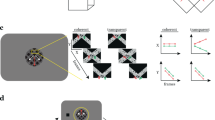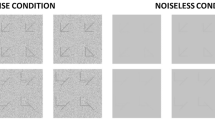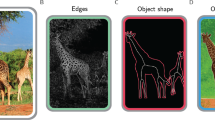Abstract
Object perception depends on shape processing in the ventral visual pathway, which in monkeys culminates in inferotemporal cortex (IT). Here we provide a description of fundamental quantitative principles governing neural selectivity for complex shape in IT. By measuring responses to large, parametric sets of two-dimensional (2D) silhouette shapes, we found that neurons in posterior IT (Brodmann's areas TEO and posterior TE) integrate information about multiple contour elements (straight and curved edge fragments of the type represented in lower-level areas) using both linear and nonlinear mechanisms. This results in complex, distributed response patterns that cannot be characterized solely in terms of example stimuli. We explained these response patterns with tuning functions in multidimensional shape space and accurately predicted neural responses to the widely varying shapes in our stimulus set. Integration of contour element information in earlier stages of IT represents an important step in the transformation from low-level shape signals to complex object representation.
This is a preview of subscription content, access via your institution
Access options
Subscribe to this journal
Receive 12 print issues and online access
$209.00 per year
only $17.42 per issue
Buy this article
- Purchase on Springer Link
- Instant access to full article PDF
Prices may be subject to local taxes which are calculated during checkout




Similar content being viewed by others
References
Gross, C.G., Rocha-Miranda, C.E. & Bender, D.B. Visual properties of neurons in inferotemporal cortex of the Macaque. J. Neurophysiol. 35, 96–111 (1972).
Kobatake, E. & Tanaka, K. Neuronal selectivities to complex object features in the ventral visual pathway of the macaque cerebral cortex. J. Neurophysiol. 71, 856–867 (1994).
Booth, M.C. & Rolls, E.T. View-invariant representations of familiar objects by neurons in the inferior temporal visual cortex. Cereb. Cortex 8, 510–523 (1998).
Fujita, I., Tanaka, K., Ito, M. & Cheng, K. Columns for visual features of objects in monkey inferotemporal cortex. Nature 360, 343–346 (1992).
Young, M.P. & Yamane, S. Sparse population coding of faces in the inferotemporal cortex. Science 256, 1327–1331 (1992).
Rolls, E.T., Treves, A. & Tovee, M.J. The representational capacity of the distributed encoding of information provided by populations of neurons in primate temporal visual cortex. Exp. Brain Res. 114, 149–162 (1997).
Op de Beeck, H., Wagemans, J. & Vogels, R. Inferotemporal neurons represent low-dimensional configurations of parameterized shapes. Nat. Neurosci. 4, 1244–1252 (2001).
Tsunoda, K., Yamane, Y., Nishizaki, M. & Tanifuji, M. Complex objects are represented in macaque inferotemporal cortex by the combination of feature columns. Nat. Neurosci. 4, 832–838 (2001).
Sakai, K. & Miyashita, Y. Neural organization for the long-term memory of paired associates. Nature 354, 152–155 (1991).
Miller, E.K. & Desimone, R. Parallel neuronal mechanisms for short-term memory. Science 263, 520–522 (1994).
Sigala, N. & Logothetis, N.K. Visual categorization shapes feature selectivity in the primate temporal cortex. Nature 415, 318–320 (2002).
Baker, C.I., Behrmann, M. & Olson, C.R. Impact of learning on representation of parts and wholes in monkey inferotemporal cortex. Nat. Neurosci. 5, 1210–1216 (2002).
Pasupathy, A. & Connor, C.E. Population coding of shape in area V4. Nat. Neurosci. 5, 1332–1338 (2002).
Wang, Y., Fujita, I. & Murayama, Y. Neuronal mechanisms of selectivity for object features revealed by blocking inhibition in inferotemporal cortex. Nat. Neurosci. 3, 807–813 (2000).
Carandini, M., Heeger, D.J. & Movshon, J.A. Linearity and normalization in simple cells of the macaque primary visual cortex. J. Neurosci. 17, 8621–8644 (1997).
Mechler, F. & Ringach, D.L. On the classification of simple and complex cells. Vision Res. 42, 1017–1033 (2002).
Ito, M., Tamura, H., Fujita, I. & Tanaka, K. Size and position invariance of neuronal responses in monkey inferotemporal cortex. J. Neurophysiol. 73, 218–226 (1995).
DiCarlo, J.J. & Maunsell, J.H. Anterior inferotemporal neurons of monkeys engaged in object recognition can be highly sensitive to object retinal position. J. Neurophysiol. 89, 3264–3278 (2003).
Op de Beeck, H. & Vogels, R. Spatial sensitivity of macaque inferior temporal neurons. J. Comp Neurol. 426, 505–518 (2000).
Jones, J.P. & Palmer, L.A. The two-dimensional spatial structure of simple receptive fields in cat striate cortex. J. Neurophysiol. 58, 1187–1211 (1987).
Ringach, D.L., Sapiro, G. & Shapley, R. A subspace reverse-correlation technique for the study of visual neurons. Vision Res. 37, 2455–2464 (1997).
Theunissen, F.E. et al. Estimating spatio-temporal receptive fields of auditory and visual neurons from their responses to natural stimuli. Network 12, 289–316 (2001).
Marr, D. & Nishihara, H.K. Representation and recognition of the spatial organization of three-dimensional shapes. Proc. R. Soc. Lond B Biol. Sci. 200, 269–294 (1978).
Biederman, I. Recognition-by-components: a theory of human image understanding. Psychol. Rev. 94, 115–147 (1987).
Salinas, E. & Abbott, L.F. Invariant visual responses from attentional gain fields. J. Neurophysiol. 77, 3267–3272 (1997).
Wilson, H.R., Wilkinson, F. & Asaad, W. Concentric orientation summation in human form vision. Vision Res. 37, 2325–2330 (1997).
Riesenhuber, M. & Poggio, T. Hierarchical models of object recognition in cortex. Nat. Neurosci. 2, 1019–1025 (1999).
Mel, B.W. & Fiser, J. Minimizing binding errors using learned conjunctive features. Neural Comput. 12, 731–762 (2000).
Edelman, S. & Intrator, N. Towards structural systematicity in distributed, statically bound visual representations. Cognit. Sci. 27, 73–109 (2003).
Janssen, P., Vogels, R. & Orban, G.A. Macaque inferior temporal neurons are selective for disparity-defined three-dimensional shapes. Proc. Natl. Acad. Sci. USA 96, 8217–8222 (1999).
Kovacs, G. et al. Effects of surface cues on macaque inferior temporal cortical responses. Cereb. Cortex 13, 178–188 (2003).
Barlow, H. Redundancy reduction revisited. Network 12, 241–253 (2001).
Olshausen, B.A. & Field, D.J. Sparse coding with an overcomplete basis set: a strategy employed by V1? Vision Res. 37, 3311–3325 (1997).
Vinje, W.E. & Gallant, J.L. Sparse coding and decorrelation in primary visual cortex during natural vision. Science 287, 1273–1276 (2000).
Kapadia, M.K., Westheimer, G. & Gilbert, C.D. Spatial distribution of contextual interactions in primary visual cortex and in visual perception. J. Neurophysiol. 84, 2048–2062 (2000).
Polat, U., Mizobe, K., Pettet, M.W., Kasamatsu, T. & Norcia, A.M. Collinear stimuli regulate visual responses depending on cell's contrast threshold. Nature 391, 580–584 (1998).
Gallant, J.L., Braun, J. & Van Essen, D.C. Selectivity for polar, hyperbolic, and Cartesian gratings in macaque visual cortex. Science 259, 100–103 (1993).
Wolfe, J.M., Yee, A. & Friedman-Hill, S.R. Curvature is a basic feature for visual search tasks. Perception 21, 465–480 (1992).
Olson, C.R. & Gettner, S.N. Object-centered direction selectivity in the macaque supplementary eye field. Science 269, 985–988 (1995).
Connor, C.E., Preddie, D.C., Gallant, J.L. & Van Essen, D.C. Spatial attention effects in macaque area V4. J. Neurosci. 17, 3201–3214 (1997).
Zhou, H., Friedman, H.S. & von der Heydt, R. Coding of border ownership in monkey visual cortex. J. Neurosci. 20, 6594–6611 (2000).
Schwartz, E.L., Desimone, R., Albright, T.D. & Gross, C.G. Shape recognition and inferior temporal neurons. Proc. Natl. Acad. Sci. USA 80, 5776–5778 (1983).
Albright, T.D. & Gross, C.G. Do inferior temporal neurons encode shape by acting as fourier descriptor filters? Proc. Int. Conf. on Fuzzy Logic & Neural Networks 2, 375–378 (1990).
Optican, L.M. & Richmond, B.J. Temporal encoding of two-dimensional patterns by single units in primate inferior temporal cortex. III. Information theoretic analysis. J. Neurophysiol. 57, 162–178 (1987).
Gochin, P.M., Colombo, M., Dorfman, G.A., Gerstein, G.L. & Gross, C.G. Neural ensemble coding in inferior temporal cortex. J. Neurophysiol. 71, 2325–2337 (1994).
Ullman, S. Three-dimensional object recognition based on the combination of views. Cognition 67, 21–44 (1998).
Tanaka, K. Inferotemporal cortex and object vision. Annu. Rev. Neurosci. 19, 109–139 (1996).
Hoffman, D.D. & Richards, W.A. Parts of recognition. Cognition 18, 65–96 (1984).
Leyton, M. A Generative Theory of Shape (Springer, Berlin, 1998).
Kimia, B.B. On the role of medial geometry in human vision. J. Physiol. (Paris) 97, 155–190 (2003).
Acknowledgements
We thank W. Nash, W. Quinlan, B. Sorensen and L. Ziehm for technical assistance, and A. Bastian, D. Hinkle, K. Johnson and R. von der Heydt for helpful comments. Our implementation of Hartigan's dip test is based on public domain code provided by F. Mechler and D. Ringach. This work was supported by the National Eye Institute and by the Pew Scholars Program in the Biomedical Sciences.
Author information
Authors and Affiliations
Corresponding author
Ethics declarations
Competing interests
The authors declare no competing financial interests.
Supplementary information
Supplementary Fig. 1
Further empirical and analytical results for the two example neurons described in the main text. a, Modified version of main stimulus set in which one end of each stimulus was centered in the RF. Responses of the Fig. 1 example neuron are shown here (all conventions as in Fig. 1). b, Full fitted model, including tuning for absolute position, for the Fig. 1 neuron. c, Responses of the Fig. 2 example neuron to the modified main stimulus set. d, Full fitted model for the Fig. 2 neuron. (PDF 2439 kb)
Supplementary Fig. 2
Position and size consistency of shape selectivity for Fig. 1 example neuron. a, Responses of the Fig. 1 example neuron to preferred and non-preferred shapes across a range of retinotopic positions. Gray level indicates actual responses; overlaid red contours show response predictions based on this neuron's optimal model. The icon above each gray level plot shows the shape used to generate it. Crosses represent center of gaze. b, Responses of the Fig. 1 neuron to preferred and non-preferred shapes across a range of sizes. The icons above the plot show stimulus sizes, relative to estimated RF (dashed circle), at three selected points within the tested range. The gray level of each plot line indicates the shape used to generate it (corresponding to the gray levels of the icons above the plot). Dotted lines show ± s.e.m. (PDF 79 kb)
Supplementary Fig. 3
Relative contributions of model tuning dimensions. a-d, Tuning width and tuning depth index values for orientation (a), curvature (b), relative position (c), and absolute position (d) dimensions for all sampled IT neurons. e, Mean tuning depth index value across all IT neurons for each dimension; lines denote upper and lower 99% confidence intervals (bootstrapped). f, Mean (± 99% confidence intervals) tuning width index value across all IT neurons for each dimension. (PDF 78 kb)
Rights and permissions
About this article
Cite this article
Brincat, S., Connor, C. Underlying principles of visual shape selectivity in posterior inferotemporal cortex. Nat Neurosci 7, 880–886 (2004). https://doi.org/10.1038/nn1278
Received:
Accepted:
Published:
Issue Date:
DOI: https://doi.org/10.1038/nn1278
This article is cited by
-
The importance of contrast features in rat vision
Scientific Reports (2023)
-
Integration of landmark and saccade target signals in macaque frontal cortex visual responses
Communications Biology (2023)
-
Characterisation of nonlinear receptive fields of visual neurons by convolutional neural network
Scientific Reports (2019)
-
Task-dependent functional organizations of the visual ventral stream
Scientific Reports (2019)
-
Feature-based learning improves adaptability without compromising precision
Nature Communications (2017)



